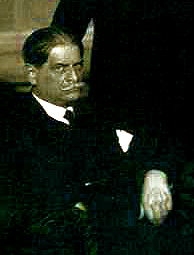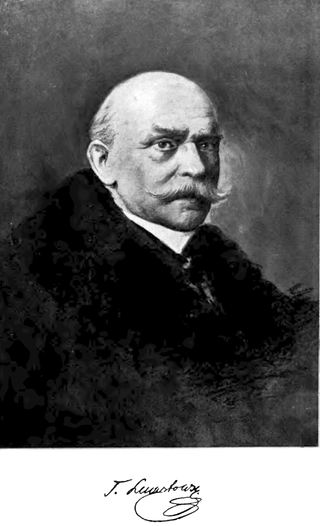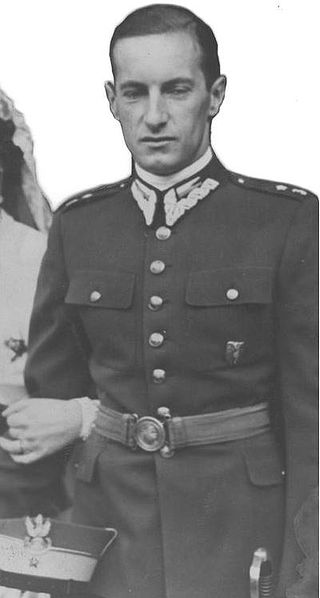
Mikołaj Mielecki h. Gryf was a Polish nobleman and politician. Since 1569 Mielecki was the voivod of Podolian Voivodship, between 1578 and 1580 he also served in the Polish Army as the Grand Hetman of the Crown.

Princess Konstancja Małgorzata Lubomirska (1761–1840) was a Polish noblewoman and artist. She was an amateur artist and some of her drawings are preserved.

General Michał Tadeusz Tokarzewski-Karaszewicz, Coat of arms of Trąby pseudonym Doktor, Stolarski, Torwid was a Polish general, founder of the resistance movement "Polish Victory Service".

Władysław Wróblewski was a Polish szlachcic, politician, scientist, diplomat and lawyer. He is notable as the last provisional prime minister of the German-controlled puppet state of Regency Kingdom before Poland regained their independence in 1918.

Kazimierz Radosław Elehard baron Kelles-Krauz was a Polish philosopher and sociologist, member of the Polish Socialist Party. He was one of the most significant Marxist thinkers at the end of the 19th century.
Michał Lubomirski (1752–1809) was a Polish military commander and a Lieutenant General of the Polish Army. A son to Stanisław Lubomirski (1704–1793), he should not be confused with his ancestor Aleksander Michał Lubomirski.

Józef Czapski was a Polish artist, author, and critic, as well as an officer of the Polish Army. As a painter, he is notable for his membership in the Kapist movement, which was heavily influenced by Cézanne. Following the Polish Defensive War, he was made a prisoner of war by the Soviets and was among the very few officers to survive the Katyn massacre of 1940. Following the Sikorski-Mayski Agreement, he was an official envoy of the Polish government searching for the missing Polish officers in Russia. After World War II, he remained in exile in the Paris suburb of Maisons-Laffitte, where he was among the founders of Kultura monthly, one of the most influential Polish cultural journals of the 20th century.

Stefan Tytus Zygmunt Dąbrowski (1877–1947) of Radwan coat of arms – Physician, physiologist, biochemist, and Polish politician. Rector: Adam Mickiewicz University - Poznań, Poland (1945–1946).

The House of Zbaraski was a princely family of Ruthenian origin in the Crown of the Kingdom of Poland domiciled in Volhynia. The name is derived from the town of Zbarazh, the core of their dominions. They were the Gediminids descended from Kaributas. The line ended in 1631, with their assets overtaken by their agnates, the Wiśniowiecki family. A branch of the princes Nieświcki family.

Teofil Aleksander Lenartowicz was a Polish ethnographer, sculptor, poet and Romantic conspirator. Linked to Bohemians among Warsaw intellectuals, Lenartowicz was associated with Oskar Kolberg and Roman Zmorski in the anti-Tsarist independence movement, and participated in the Greater Poland Uprising of 1848 during his stay in Kraków. While in exile he taught Slavic literature at the University of Bologna, composed patriotic and religious poems, as well as lyrical and historical epics based on the folklore of his beloved region of Mazowsze. He did portrait-sculptures, and designed tombstones.

Władysław Łuszczkiewicz was a Polish historian and painter of the late Romantic era from Kraków, active in the period of the foreign partitions of Poland. He was a professor at the Academy of Fine Arts and served as its principal in 1893/95. One of his best students was Jan Matejko, the eminent Polish historical painter and later, his close associate. Łuszczkiewicz taught painting, drawing, anatomy and architectural styles. Highly educated, he also worked as conservator of architectural monuments in the city later on in his career, and wrote historical dissertations.

Jan Nepomucen Głowacki was a Polish realist painter of the Romantic era, regarded as the most outstanding landscape painter of the early 19th century in Poland under the foreign partitions. Głowacki studied painting at the Kraków School of Fine Arts and later at the academies of Prague and Vienna, as well as Rome and Munich. He returned to Kraków in 1828, and became a teacher of painting and drawing. From 1842 he served as a professor in the Faculty of Landscape Painting at the School of Fine Arts. His work can be found at the National Museum of Poland and its branches. Some of his work was looted by Nazi Germany in World War II and has never been recovered.

Emeryk Hutten-Czapski, Leliwa coat of arms was a Polish Count, scholar, ardent historical collector and numismatist.

Prince Dominik Rainer Radziwiłł was a Polish aristocrat and officer of the Polish Army.
Alexander Lukasz Jogalla, known professionally as Pico Alexander, is an American actor.
Franciszek Stanislaw Kostka Hutten-Czapski, Leliwa coat of arms - Count, Polish Senator, the last Governor of Chelmno, Member of the Bar Confederation. Knight of the Order of the White Eagle (Poland)(1762). An exhibition at the Royal Castle, Warsaw between November 9, 2005 and January 31, 2006, exhibited what was purported to be Franciszeks Order of the White Eagle, donated to the National Museum, Kraków by Emeryk Hutten-Czapski.
The Łubieński family are Polish nobles who take their name from the village of Łubna-Jarosłaj near Sieradz, in central Poland. They attained magnate status in the 18th century before the Partitions of Poland. One of their number, the reformer and Minister of Justice during Congress Poland, Felix, received the hereditary title of Graf, from king Frederick Wilhelm III of Prussia in 1796. He and his wife, the writer, Tekla Teresa Lubienska had 60 grandchildren.

Romuald Giedroyć was a Polish-Lithuanian prince from the Lithuanian princely Giedraičiai family, who fought in the Bar Confederation, War of 1792 and the Uprising of 1794 as part of the Grand Ducal Lithuanian Army. From mid-1812 to early 1813, Giedroyć was also the commander of the Lithuanian regiments raised during the French invasion of Russia. In early 1813, he was captured by the Russians and exiled to Arkhangelsk. In 1815, Alexander I of Russia amnestied Giedroyć and made him a Lieutenant general of the Army of Congress Poland.
Ludwik Maria Łubieński, comte de Pomian was a Polish lawyer, diplomat and military officer. He was Head of the Polish Maritime Mission in Gibraltar during World War II and an eyewitness of the air disaster whose victim was the Polish wartime Premier and military leader, Władysław Sikorski. After the war, he became an expatriate official in Munich and London.
Mikołaj Korff – Voivode of Wenden, starosta of Kokenhaus, royal colonel, member of the noble Livionian Korff family. He was the son of Mikołaj, a rotmistrz in the army of King Stephen Báthory.













